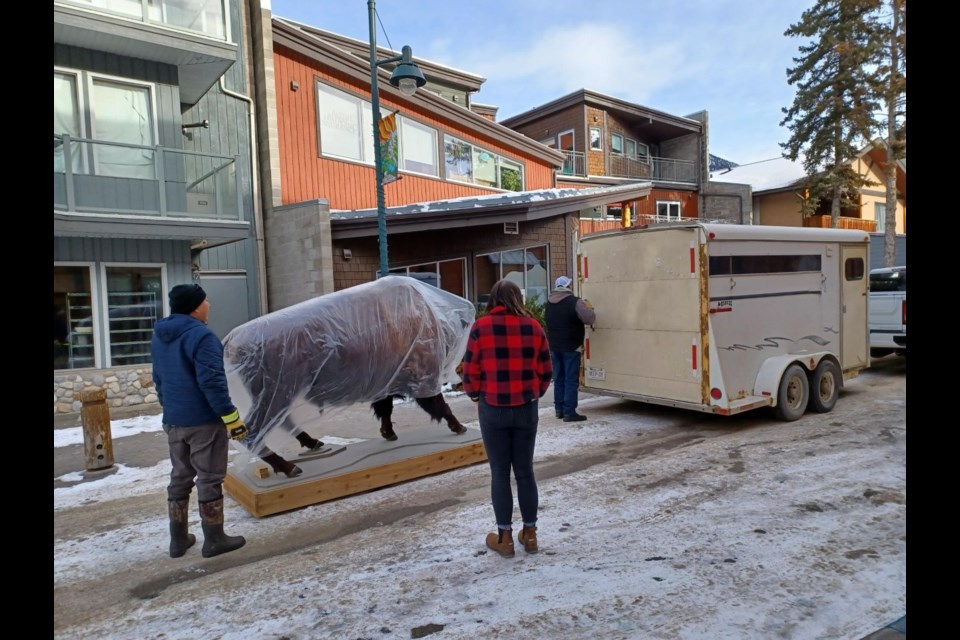ÎYÂRHE NAKODA – It’s not every day you see a full-grown taxidermy bull bison wheeled into a restaurant.
But about two weeks ago, patrons and staff at the Smitty’s and Chiniki Cultural Centre off Highway 1 were in for a special treat when Bud the bison, a beloved fixture of the Canmore Museum of 16 years made his migration to Îyârhe (Stoney) Nakoda First Nation.
Tony Frias, manager of the Chiniki First Nation-owned restaurant and cultural centre, said welcoming Bud to the building’s exhibitions felt a bit like a homecoming. The move was initiated between the Canmore Museum and Chiniki chief and councillors on Stoney Tribal Council.
“We have a tipi, we have a bunch of historical photos, we have a full-size mannequin with traditional regalia,” said Frias. “To have Bud come in – he’s a very significant piece.
“He’s a very large, sort of imposing display. People come in and see him and are in awe of how huge this animal is. It’s definitely turning a lot of heads … we think it just fights right in with everything in the interpretive centre.”
Watching staff and community members show up to welcome Bud and react to the bison’s presence has been a memorable experience, said Frias, who is not from the First Nation.
“I think it brings it home a bit for them, for sure,” he said.
Bison, also known as buffalo, are known to have lived in the Bow Valley for more than 10,000 years. Once numbering in the millions across North America, they were brought to the brink of extinction during the 19th century due to over-hunting, loss of habitat and unenforced early conservation efforts by white settlers.
For thousands of years, many Indigenous peoples travelled through what is now Banff National Park, hunting bison and burning forests and meadows to improve habitat quality for bison and other animals.
Bison provided food, clothing, tools and shelter to Indigenous peoples living in the Bow Valley area, and across North America. The animals is considered fundamental to the physical, spiritual and cultural lives of many Indigenous peoples, including Îyârhe Nakoda First Nation.
“It’s a huge cultural part of their heritage,” said Brian Evans, Chiniki First Nation CEO. “Long before treaty, First Nations throughout Canada made very good use of the bison. It’s a sacred animal.”
Some of Bud’s ancestors once roamed the traditional territory of Îyârhe Nakoda First Nation, which includes Canmore.
The decision to move the roughly 7-feet long by 6-feet tall bison fixture from the town’s museum was made because of planning new gallery redevelopments, said collections officer Mercedes Cormier.
“He takes up a lot of space and we don’t have a lot of storage space to properly take care of him and store the display when we’re not using him,” she said.
It’s common practice for museums to pass along objects or displays to other interested nearby museums or historic centres, and there was interest from Chiniki First Nation to see it installed at the band’s cultural centre.
“It was very kind of them to think of us and reach out,” said Evans. “It’s a magnificent animal and a beautiful display.”
Cormier said she was able to see Bud in his new home last week after members of Chiniki council and the cultural centre picked him up from Canmore in a horse trailer.
Prior to coming to Canmore in 2006, Bud was a real-life bison that lived on a ranch in Hudson’s Hope, B.C.
He was 12 years old when his owners made the decision to put him down, but he was “quite loved,” according to Cormier.
“He was also known as a bit of a troublemaker,” she said. “When they did have to put him down, they wanted to preserve him and keep his memory alive.”
Bud’s arrival to the Chiniki Cultural Centre will be celebrated at the site in the near future with a pipe ceremony. A date has not been set yet.
The Local Journalism Initiative is funded by the Government of Canada. The position covers Îyârhe (Stoney) Nakoda First Nation and Kananaskis Country.




